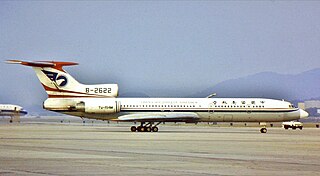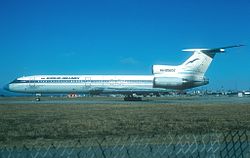
The Tupolev Tu-154 is a three-engined, medium-range, narrow-body airliner designed in the mid-1960s and manufactured by Tupolev. A workhorse of Soviet and (subsequently) Russian airlines for several decades, it carried half of all passengers flown by Aeroflot and its subsidiaries, remaining the standard domestic-route airliner of Russia and former Soviet states until the mid-2000s. It was exported to 17 non-Russian airlines and used as a head-of-state transport by the air forces of several countries.

United Airlines Flight 232 was a regularly scheduled United Airlines flight from Stapleton International Airport in Denver to O'Hare International Airport in Chicago, continuing to Philadelphia International Airport. On July 19, 1989, the DC-10 serving the flight crash-landed at Sioux Gateway Airport in Sioux City, Iowa, after suffering a catastrophic failure of its tail-mounted engine due to an unnoticed manufacturing defect in the engine's fan disk, which resulted in the loss of many flight controls. Of the 296 passengers and crew on board, 112 died during the accident, while 184 people survived. 13 of the passengers were uninjured. It was the deadliest single-aircraft accident in the history of United Airlines.

S7 Airlines Flight 778(S7778/SBI778) was a scheduled domestic passenger flight from Moscow to Irkutsk, Russia. On 9 July 2006, at 06:44 local time, the Airbus A310-324 aircraft operating the route overran the runway during its landing in Irkutsk. The aircraft failed to stop and crashed through the airport's concrete perimeter fence, struck rows of private garages and burst into flames, killing 125 people.

China Southwest Airlines Flight 4509 (SZ4509) was a domestic flight in China from Chengdu Shuangliu International Airport, Sichuan to Wenzhou Yongqiang Airport, Zhejiang. On February 24, 1999, the Tupolev Tu-154M operating the flight crashed while on approach to Wenzhou Airport, killing all 61 passengers and crew members on board.

A turbine engine failure occurs when a turbine engine unexpectedly stops producing power due to a malfunction other than fuel exhaustion. It often applies for aircraft, but other turbine engines can fail, like ground-based turbines used in power plants or combined diesel and gas vessels and vehicles.

Vladivostok Air Flight 352 was a scheduled passenger flight from Yekaterinburg, Russia to Vladivostok via Irkutsk. On 4 July 2001, the aircraft operating the flight, a Tupolev Tu-154M with tail number RA-85845, lost control, stalled, and crashed while approaching Irkutsk Airport. All 136 passengers and 9 flight crew members aboard perished, making it the third deadliest aircraft crash over Russian territory to date after Aeroflot Flight 3352 and Aeroflot Flight 217.

Aeroflot Flight 3352 was a regularly scheduled Aeroflot flight from Krasnodar to Novosibirsk, with an intermediate landing in Omsk. While landing at Omsk Airport on Thursday, 11 October 1984, the aircraft crashed into maintenance vehicles on the runway, killing 174 people on board and four on the ground. While a chain of mistakes in airport operations contributed to the accident, its major cause was an air traffic controller falling asleep on duty. As of 2022, this remains the deadliest aviation accident on Russian territory. It was also the deadliest aviation accident involving a Tupolev Tu-154 at the time until the crash of Aeroflot Flight 5143 nine months later; as of 2023, it still ranks as the second-deadliest accident involving a Tupolev Tu-154. The tragedy was kept secret for twenty years, until Komsomolskaya Pravda published an article in 2004.

China Northwest Airlines Flight 2303 was a domestic flight from Xi'an to Guangzhou, People's Republic of China. On June 6, 1994, the aircraft operating the flight, a Tupolev Tu-154M, broke up in-flight and crashed as a result of an autopilot malfunction which caused violent shaking and overstressed the airframe. All 160 people on board were killed. As of 2024, it remains the deadliest airplane crash ever in mainland China.

Caspian Airlines Flight 7908 was a scheduled commercial flight from Tehran, Iran, to Yerevan, Armenia, that crashed near the village of Jannatabad, outside the city of Qazvin in north-western Iran, on 15 July 2009. All 153 passengers and 15 crew on board died.
This is a list of aviation-related events from 2010.
Several aviation incidents and accidents have occurred in which the control surfaces of an aircraft became disabled, often due to failure of hydraulic systems or the flight control system. Other incidents have occurred where controls were not functioning correctly prior to take-off, either due to maintenance or pilot error, and controls can become inoperative from extreme weather conditions. Aircraft are not designed to be flown in such circumstances; however, a small number of pilots have had some success in flying and landing aircraft with disabled controls.

Dagestan Airlines Flight 372 was a scheduled commercial flight between Moscow's Vnukovo Airport and Makhachkala, Russia. On 4 December 2010, the Tupolev Tu-154 operating the flight skidded off the runway following an emergency landing at Domodedovo Airport, 45 kilometres (28 mi) south-east of Vnukovo. Two people on board were killed.
In aeronautics, loss of control (LOC) is the unintended departure of an aircraft from controlled flight and is a significant factor in several aviation accidents worldwide. In 2015 it was the leading cause of general aviation accidents. Loss of control may be the result of mechanical failure, external disturbances, aircraft upset conditions, or inappropriate crew actions or responses.

Iran Air Tours Flight 956 was a Tupolev Tu-154M which crashed 230 miles (370 km) south-west of Tehran on 12 February 2002. During a non precision approach to runway 11, the airliner impacted the Kuh-e Sefid Mountain at an altitude of 9,100 feet (2,800 m), three nautical miles left of the runway centerline. All 12 crew and 107 passengers were killed in the crash. The aircraft was carrying four government officials. It remains the 5th worst plane crash in Iranian history.

Aeroflot Flight 3519 was a Tupolev Tu-154B-2 airline flight on a domestic route from Krasnoyarsk to Irkutsk on 23 December 1984. Shortly after takeoff, the No. 3 engine caught fire, and the airplane crashed during an emergency landing. This killed 110 people; there was only one survivor, and the aircraft was destroyed. The engine fire was caused by a manufacturing defect in the compressor disk.
Mamony is a village located in Irkutsky District, Irkutsk Oblast, Russia. The administrative center of the Mamony municipality, Mamony is located approximately 7 kilometres west of Irkutsk.

The 1978 Yegoryevsk Tu-144 crash occurred during a test flight of a Tupolev Tu-144 on 23 May 1978. The aircraft suffered a fuel leak, which led to an in-flight fire in the right wing, forcing the shutdown of two of the aircraft's four engines. One of the two remaining engines subsequently failed, forcing the crew to make a belly landing in a field near Yegoryevsk, Moscow Oblast. Two flight engineers were killed in the ensuing crash, but the remaining six crew members survived. The accident prompted a ban on passenger flights of the Tu-144, which had already been beset by numerous problems, leading to a lack of interest that ultimately resulted in the Tu-144 program's cancellation.














